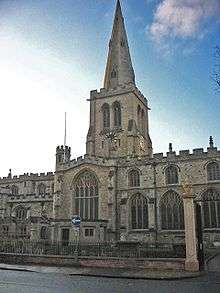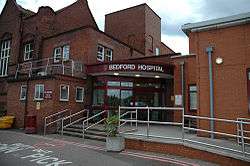Bedford
Bedford is a historic market and the county town of Bedfordshire, England. At the 2011 Census, the population of the Bedford built-up area was 106,940,[1][lower-alpha 1] while that within its traditional boundary was 87,590.[2][lower-alpha 2] At the same census, the Borough of Bedford had a population of 157,479.[1]
| Bedford | |
|---|---|
| Town | |
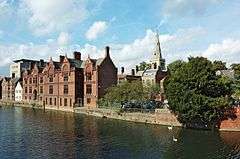 Shire Hall and St Paul's Church by the River Great Ouse | |
 Bedford Location within Bedfordshire | |
| Population | 106,940 [1] |
| OS grid reference | TL055495 |
| • London | 46 miles (74 km) S |
| Unitary authority | |
| Ceremonial county | |
| Region | |
| Country | England |
| Sovereign state | United Kingdom |
| Post town | BEDFORD |
| Postcode district | MK40–MK45 |
| Dialling code | 01234 |
| Police | Bedfordshire |
| Fire | Bedfordshire and Luton |
| Ambulance | East of England |
| UK Parliament | |
Bedford was founded at a ford on the River Great Ouse, and is thought to have been the burial place of Offa of Mercia. Bedford Castle was built by Henry I, although it was destroyed in 1224. Bedford was granted borough status in 1165 and has been represented in Parliament since 1265. It is known for its large population of Italian descent.[3]
Bedford is on the Midland Main Line, with stopping services to London and Brighton operated by Thameslink, and express services to London and the East Midlands operated by East Midlands Railway.
History
The name of the town is believed to derive from the name of a Saxon chief called Beda,[4] and a ford crossing the River Great Ouse. Bedford was a market town for the surrounding agricultural region from the early Middle Ages. The Anglo-Saxon King Offa of Mercia was buried in the town in 796;[5] this is believed to be in his new minster, now the Church of St Paul,[6] or on the banks of the Great Ouse where his tomb was soon lost to the river.[7] In 886 it became a boundary town separating Wessex and Danelaw.[8][9] It was the seat of the Barony of Bedford. In 919 Edward the Elder built the town's first known fortress, on the south side of the River Great Ouse and there received the area's submission. This fortress was destroyed by the Danes. William II gave the barony of Bedford to Paine de Beauchamp, who built a new, strong castle.
Bedford traces its borough charter in 1166 by Henry II[10] and elected two members to the unreformed House of Commons. The new Bedford Castle was razed in 1224 and today only a mound remains. From the 16th century Bedford and much of Bedfordshire became one of the main centres of England's lace industry, and lace continued to be an important industry in Bedford until the early 20th century. In 1660 John Bunyan was imprisoned for 12 years in Bedford Gaol. It was here that he wrote The Pilgrim's Progress.[11] The River Great Ouse became navigable as far as Bedford in 1689. Wool declined in importance with brewing becoming a major industry in the town. The 19th century saw Bedford transform into an important engineering hub. In 1832 gas lighting was introduced, and the railway reached Bedford in 1846. The first corn exchange was built 1849,[12] and the first drains and sewers were dug in 1864.[13]
.jpg) Bedford in 1611
Bedford in 1611_by_Francis_Grose.jpg) Bedford Bridge in 1783. This version of the bridge was replaced in 1813.
Bedford Bridge in 1783. This version of the bridge was replaced in 1813. Bedford in 1806
Bedford in 1806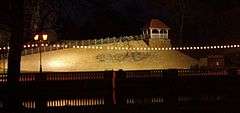
Governance
Bedford is the largest settlement in Borough of Bedford. The borough council is led by a directly elected mayor who holds the title 'Mayor of Bedford', an office which was first held by Frank Branston, until his death in 2009. The current Mayor of Bedford is Dave Hodgson from the Liberal Democrats.
Bedford itself is divided into 10 wards: Brickhill, Castle, Cauldwell, De Parys, Goldington, Harpur, Kingsbrook, Newnham, Putnoe, Queens Park, Kempston East and Kempston West. Brickhill elects its own parish council, while the rest (and majority) of Bedford is an unparished area.
Bedford is served by Bedfordshire Police. The Bedfordshire Police and Crime Commissioner of that force is Kathryn Holloway.
Bedford forms part of the Bedford constituency, represented in the House of Commons of the United Kingdom Parliament. The current Member of Parliament (MP) for Bedford is Mohammad Yasin, who is a member of the Labour Party.
Geography
Bedford is 46 miles (74 km) miles north-northwest of London, 65 miles (105 km) southeast of Birmingham, 25 miles (40 km) west of Cambridge and 19 miles (31 km) east-southeast of Northampton. The town of Kempston is adjacent to Bedford, as are the villages of Elstow, Renhold and Ravensden. Wixams is a new town which is being developed to the south of Bedford. Villages in the Borough of Bedford with populations of more than 2,000 as of 2005 were Biddenham, Bromham, Clapham, Elstow, Oakley, Sharnbrook, Shortstown, Wilstead, and Wootton. There are also many smaller villages in the borough. The villages in the borough are popular with commuters to Bedford, and also with people who commute to Milton Keynes, London and towns in Northamptonshire and Cambridgeshire.

Climate
As with the rest of the United Kingdom, Bedford has a maritime climate, with a limited range of temperatures, and generally even rainfall throughout the year. The nearest Met Office weather station to Bedford is Bedford (Thurleigh) airport, about 6.5 miles north of Bedford town centre at an elevation of 85 metres. Since 1206, temperature extremes at the site have ranged from 35.9 °C(97F)[14] in August 2003 and 35.3 °C(95F)[15] during July 2006 down to −15.3 °C(4F)[16] in January 1982. However, such extremes would likely be superseded if longer term records were available – Historically, the nearest weather station to Bedford was Cardington about 2.4 miles south south east of the town centre with an elevation of 30 metres. This location recorded a minimum of −18.3 °C(-1F)[17] during January 1963.
Rainfall averages around 585mm (23.03 in) a year, with an excess of 1mm (.04in) falling on 109 days.
Sunshine at around 1500 hours a year is typical of inland areas of southern-central England.
| Climate data for Bedford (Thurleigh) 85m, 1971–2000, extremes Woburn 1928- | |||||||||||||
|---|---|---|---|---|---|---|---|---|---|---|---|---|---|
| Month | Jan | Feb | Mar | Apr | May | Jun | Jul | Aug | Sep | Oct | Nov | Dec | Year |
| Record high °C (°F) | 15.0 (59.0) |
19.2 (66.6) |
22.8 (73.0) |
27.4 (81.3) |
29.4 (84.9) |
33.3 (91.9) |
37.5 (99.5) |
35.0 (95.0) |
30.9 (87.6) |
27.5 (81.5) |
19.4 (66.9) |
16.1 (61.0) |
37.5 (99.5) |
| Average high °C (°F) | 6.4 (43.5) |
6.9 (44.4) |
9.7 (49.5) |
12.0 (53.6) |
15.7 (60.3) |
18.6 (65.5) |
21.5 (70.7) |
21.5 (70.7) |
18.2 (64.8) |
14.0 (57.2) |
9.5 (49.1) |
7.2 (45.0) |
13.5 (56.3) |
| Average low °C (°F) | 0.8 (33.4) |
0.6 (33.1) |
2.3 (36.1) |
3.6 (38.5) |
6.2 (43.2) |
9.3 (48.7) |
11.5 (52.7) |
11.6 (52.9) |
9.7 (49.5) |
6.6 (43.9) |
3.3 (37.9) |
1.8 (35.2) |
5.6 (42.1) |
| Record low °C (°F) | −20.0 (−4.0) |
−15.6 (3.9) |
−15.0 (5.0) |
−7.3 (18.9) |
−5.6 (21.9) |
−0.6 (30.9) |
1.2 (34.2) |
1.7 (35.1) |
−2.2 (28.0) |
−7.8 (18.0) |
−9.4 (15.1) |
−16.3 (2.7) |
−20.0 (−4.0) |
| Average precipitation mm (inches) | 48.4 (1.91) |
36.6 (1.44) |
43.5 (1.71) |
47.2 (1.86) |
45.3 (1.78) |
56.9 (2.24) |
44.7 (1.76) |
48.6 (1.91) |
53.6 (2.11) |
56.8 (2.24) |
49.0 (1.93) |
53.8 (2.12) |
584.4 (23.01) |
| Mean monthly sunshine hours | 58.6 | 76.3 | 99.5 | 153.0 | 183.8 | 185.7 | 200.9 | 188.5 | 139.8 | 114.1 | 72.0 | 51.5 | 1,523.6 |
| Source: [18] | |||||||||||||
Demography
Bedford is home to one of the largest concentrations of Italian immigrants in the United Kingdom. According to the 2001 census, almost 30% of Bedford's population were of at least partial Italian descent. This is mainly as a result of labour recruitment in the early 1950s by the London Brick Company from Southern Italy.[19] From 1954 to 2008 Bedford had its own Italian vice-consulate.[20]
At the 2011 Census, the ethnic mix of the Bedford urban area was 74.4% white, 4% mixed, 15% Asian/Asian British, 5% Black/African/Caribbean/Black British, and 1% "other ethnic group".[1] In terms of national identity, just over 50% identified as English only, 24% as British only and 15% only as a non-UK identity; just over 8% had a "British and other" identity.[1] In terms of religious affiliation, 56% were Christian, almost 8% were Muslim, almost 3% Sikh and 2% Hindu; almost 30% had no religion or declined to answer.[1]
Landmarks
Bedford Park is the town's largest urban park and is located directly to the north of the town centre. The park retains many original features from its Victorian design and construction, including a cricket pavilion and bandstand which are both still in use. Priory Country Park is a large country park located on the northern bank of the River Great Ouse in eastern Bedford. Both parks have been awarded Green Flag status.
Bedford's principal church is St Paul's, in the square of the same name at the historic centre of the town. It is the Civic Church of the Borough of Bedford and County of Bedfordshire and has a tall, iconic spire which is one of the dominant features of the town. There was an early Minster church on the site by 1066 and work on the present structure began in the early 13th century, but little remains from that period. John Bunyan and John Wesley both preached in the church. In 1865–1868 the tower and spire were completely rebuilt and the two transepts added and lesser alterations have been made since. From 1941 to the end of the Second World War the BBC's daily service was broadcast from St. Paul's.[21] Another notable local church is St Peter's, on St Peter's Street, which contains some of the oldest architectural remains in Bedford, the most ancient being the two monoliths. St. Paul's Church also hosts the town's Visitor Information Centre.[22]
Just outside the town lie the Cardington airship hangars. The hangars have been used to shoot scenes for movies such as Star Wars, Batman Begins, The Dark Knight,[23] and Inception.[24] The hangars can be seen from the Bedford Bypass.
Despite being far upriver from the sea, seals have occasionally been reported as swimming as far inland as Bedford.[25][26][27]
River Great Ouse
The River Great Ouse passes through the town centre and is lined with gardens known as the Embankment. Within these gardens, opposite Rothsay Road, stands a war memorial to the men of the town killed in the First World War. The memorial was designed in 1921 by the sculptor Charles Sargeant Jagger and depicts the Anglo Saxon Lady Athelflaed, who ruled Mercia,killing a dragon.[28] The inscription reads
1914 † 1919
TO BEDFORDIANS WHO DIED, MANY IN EARLY YOUTH, SOME FULL OF YEARS AND HONOUR, BUT WHO ALL ALIKE GAVE THEIR LIVES FOR THEIR COUNTRY.
Bedford Castle
Bedford Castle Mound is the remnant of Bedford's medieval castle, located close to the centre of the modern town, less than a hundred yards from Bedford Bridge and the High Street. In around 2000 Bedford Borough Council built a sloping retaining wall on the south side, facing the river. Although almost completely modern, the wall does incorporate a few pieces of historic masonry. A paved path leads round the side of the mound up to the top, which is a flat circular grassy area. A small wooden structure of the same date at the top of the wall, much like a bus shelter, protects tourists from the rain while they view the river embankment.
Transport
Transport in Bedford provides links between the town and other parts of England. Road access to the town is provided by the A6 road & the A421 road. The town is served by two railway stations and a network of bus services.
Bedford bus station
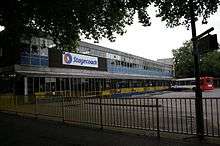
Bedford bus station serves the town of Bedford, and was reopened on 29 March 2015 after undergoing £8.8million regeneration which began in 2013. The new Greyfriars surface car park and the refurbished Allhallows multi-story car park both implement a pay on foot system. Greyfriars occupies 142 parking spaces, including 7 designated disabled spaces, although there is a 2-hour per day parking limit.[29] The main operator at Bedford bus station is Stagecoach in Bedford and Stagecoach in Northants.[30]
Education
Bedford previously operated a three-tier education system, which was arranged into lower, middle and upper schools, as recommended in the Plowden Report of 1967. The arrangement was put to the vote in 2006 with a view to moving to the two-tier model, but was rejected.[31] On 17 November 2009, borough councillors voted 19 to 17 in favour of a two tier system, which would then be phased in. However, following the defeat of the Labour Government in 2010, the new coalition government announced that the funding necessary for the switch to a two-tier system would no longer be available. As a result, the switch proceeded on a school by school basis as national funding was due to cover most of the cost. However, in July 2015, the Council announced the intention to support the transition to a system of two tier education across the whole Borough in a coordinated way. At the time, only the Wootton cluster of schools chose to not to transition. As of September 2018 all of the towns schools have converted to two-tier. The secondary schools currently operating in the town are Bedford Academy, Bedford Free School, Biddenham International School, Castle Newnham School, Goldington Academy, Mark Rutherford School and St Thomas More Catholic School.
Bedford is home to four private schools run by the Harpur Trust charity, endowed by Bedfordian Sir William Harpur in the 16th century. These are:
- Bedford School for boys aged 7–18
- Bedford Modern School, a former boys' school which became co-educational in 2003 for pupils aged 7–18
- Bedford Girls' School for girls aged 7–18. (Merged September 2012 – Formerly Bedford High School for Girls and Dame Alice Harpur School)
- Pilgrims Pre-Preparatory School
Smaller private institutions include Rushmoor School (boys aged 3–16, girls 3–11) St. Andrew's School (girls aged 3–16, boys 3–9), and Polam School (boys and girls aged 12 months to 9 years), none of which are part of the Harpur Trust.
Bedford hosts a campus of the University of Bedfordshire, which prior to a merger with the University of Luton in 2006 had been a campus of De Montfort University (itself now solely based in Leicester). For further education, the town is served by Bedford College. Additionally, Stella Mann College is a private college, which offers a range of further education courses relating to the performing arts.
Religious sites
The town has a high number of Christian churches: including the Civic and County Church of St Paul's and the Church of St Peter's, both already noted above. There are three from the Newfrontiers network, as well as Polish, Arab, Portuguese, Spanish and Italian Roman Catholic churches, LDS (Mormon) meeting houses, Greek and Russian Orthodox churches, Anglican churches and various independent churches and other places of worship that cater to the different ethnic and language groups. There are four mosques in the town. There are also Buddhist and Hindu temples in the town.
Bedford has the largest Sikh gurudwara in the United Kingdom outside London, alongside two other Sikh gurudwaras; one of which is in Kempston. Bedford has Guru Ravidass and Valmiki temples.
There are Quaker, Jehovah's Witness and Wiccan communities who meet and have their own places of worship in the town. There is no longer a synagogue in Bedford, but Bedfordshire Progressive Synagogue,[32] based in Luton, meets in Bedford once a month for the town's Jewish community. The nearest Orthodox synagogue is the Luton Hebrew Congregation, a Lubavitch synagogue in Luton. Bedford is the former headquarters of the Panacea Society who believed that the town would have an important role in the Second Coming of Jesus Christ, and that Bedford was the original location of the Garden of Eden.[33]
Culture
The Higgins Art Gallery & Museum, Bedford is housed in the recreated Victorian home of the Higgins family of Victorian brewers and in a modern extension. The museum has local history collections, while the galleries have notable collections of watercolours, prints and drawings, ceramics, glass and lace.
The Panacea Museum tells the story of the Panacea Society, a religious community formed in the early twentieth century.
The Bedford Corn Exchange is the largest entertainment venue in the town and plays host to a variety of performances, meetings, conferences, concerts and private functions. The venue has been host to many great entertainers such as Glenn Miller and Bob Hope.
The University of Bedfordshire Theatre is the largest theatre in Bedford and hosts many larger productions as well as projects from the university. There is an active amdram (community theatre) scene, with groups such as the Swan Theatre Company, Bedford Drama Company (formerly Bedford Dramatic Club), Bedford Marianettes and ShowCo Bedford producing plays and musicals in venues like the Place Theatre and the Corn Exchange. The Bedford Pantomime Company produces a traditional pantomime at the Bedford Corn Exchange each Christmas. Esquires (one of the town's premier live music venues) regularly plays host to many notable bands and acts from all over the United Kingdom as well as showcasing local live music.[34]
Every two years, an event called the "Bedford River Festival" is held near the river in Bedford during early July. The event lasts for two days and regularly attracts about 250,000 visitors. The event includes sports, funfairs and live music. It is the second-largest regular outdoor event in the United Kingdom, beaten in numbers only by the Notting Hill Carnival.[35] The Bedford Regatta each May is Britain's largest one-day river rowing regatta.
Other annual events include "Bedford by the Sea" (when large quantities of sand are deposited in the town centre), the "Bedford International Kite Festival" and "Bedford Festival of Motoring" in June.[36] "Proms in the Park", held in early August, is a popular musical event.
Bedford's special brand of the ordinary has resulted in regular small TV and radio appearances, for instance the joyful episode of Mark Steel's in Town [37] contrasting with the less enthusiastic treatment in "The Late Show with Stephen Colbert". The "Bedford of Bedfordshire's Community Calendar" segment of this US show featured Bedford born John Oliver.
Sports
There is a long-standing sporting heritage in Bedford Borough with long-established rugby and football clubs. Bedford has four rugby union teams called Bedford Blues, Bedford Queens, Bedford Swifts and Bedford Athletic, and, since 2004, also has a rugby league team, Bedford Tigers, who compete one tier below the National Conference. Bedford Blues are currently in the second tier of English rugby, but have previously been in the top division. Bedford Blues RFC's Goldington Road ground holds in the region of 5,000 spectators with an average gate of 3,000 for home games.
Taking into account the size of its overall urban area, Bedford is one of the largest towns in England without a fully professional football team. Bedford Town F.C. currently plays at the eighth level of the English football league system and Bedford F.C. play at the 11th level.
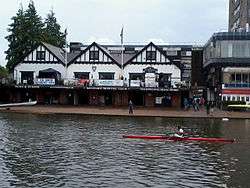
Rowing is also a major part of the sports scene with a number of regatta events hosted throughout the year from February to October; the most significant of these being Bedford Regatta, which in terms of numbers of crews participating is the second largest in the country. It was on Bedford's River Great Ouse that Olympic rower, Tim Foster, honed his skills as a student of Bedford Modern and member of star club; indeed the borough has produced many other champions of sport past and present including Stephanie Cook, Gail Emms, Liz Yelling and Paula Radcliffe who is Life Vice-President of Bedford & County Athletic Club
Viking Kayak Club organise the Bedford Kayak Marathon with canoe racing held along the Embankment on Bedford's riverside and organise national ranking Canoe Slalom events at the Cardington Artificial Slalom Course (CASC), which was the first artificial whitewater course in the United Kingdom. CASC is also the venue each year for the United Kingdom's National Inter Clubs Slalom Finals, the largest canoe slalom event by participation in the United Kingdom. Etienne Stott – 2012 Olympic Gold Medallist's Club.
Bedford and the surrounding borough was a major host of national teams preparing for the 2012 Summer Olympics and Paralympics. The Maldives National Olympic Committee based its competing athletes in the town and borough, while Paralympic athletes from Angola, the Central African Republic, Democratic Republic of the Congo, the Gambia, Ghana, Ivory Coast, Jamaica, Lesotho, Morocco, Niger, Pakistan, Senegal, Tunisia and Uganda were also be based in the area. With the exception of Weymouth (which hosted various sailing events) Bedford accommodated more Olympic teams in 2012 than any other town or borough in the United Kingdom.[38]
It is also home to the United Kingdom's largest outdoor fitness company, Be Military Fit which operates in Bedford Park.
Filmography
- The popular BBC TV series Some Mothers Do 'Ave 'Em was filmed in and around Bedford during the 1970s.[39]
- In the 2006 Comedy Central and DVD versions of Russell Peters' Outsourced, a good natured Bedfordian bears the brunt of Russell's comedic segment "I'm from England".
- A 2017 feature on The Late Show with Stephen Colbert called Bedford of Bedfordshire's Community Calendar, in which John Oliver, who grew up in Bedford, described the town as 'scrappy'. The segment featured the Shuttleworth Collection, the Forest of Marston Vale, the Place Theatre, the Bedford Corn Exchange and local bookshop Rogan's Books, among others.
Public services
Bedford Hospital is a district general hospital that operates from two sites in the town, providing a wide range of services, although patients requiring advanced health services are referred to specialist units elsewhere, particularly Addenbrooke's Hospital in Cambridge, which has a partnership with Bedford Hospital. Bedford Hospital's catchment area is based on the Borough of Bedford and parts of Central Bedfordshire.
The Bedfordshire Police is responsible for policing in Bedford, and operates a main police station in the town centre. Fire and rescue services in Bedford are coordinated by the Bedfordshire and Luton Fire and Rescue Service. Bedford's fire station is in the Newnham area of the town, and is staffed 24 hours a day.
Notable people
See also
Notes and references
- Includes Biddenham and Kempston
- Includes Biddenham
- UK Census (2011). "Local Area Report – Bedford Built-up Area (E34004993)". Nomis. Office for National Statistics. Retrieved 26 July 2019.
- UK Census (2011). "Local Area Report – Bedford Built-up Area Sub-division (E35001257)". Nomis. Office for National Statistics. Retrieved 26 July 2019.
- The Guardian. "Italians in Bedford".
- "Brief History of Bedford". Bedford Borough Council. Archived from the original on 8 December 2015. Retrieved 29 March 2011.
- Simon Keynes, "Cynethryth", in Lapidge, Encyclopaedia of Anglo-Saxon England, p. 133.
- Haslam, Jeremy (1986). "The Ecclesiastical Topography of Early Medieval Bedford". Bedfordshire Archaeological Council Publications. 17 (17): 41–2, 46, 48.
- "King Offa's tomb". wordpress.com. Retrieved 29 December 2016.
- "Bedford Timeline, Earliest Times – 1800". Bedfordshire Libraries. Archived from the original on 1 December 2008. Retrieved 10 February 2008.
- Whitelock, Dorothy (1979). Douglas, David C. (ed.). English Historical Documents c. 500–1042 (2nd ed.). Routledge. Retrieved 10 February 2008.
- "Brief History of Bedford". Bedford Borough Council. Retrieved 10 February 2008.
- "John Bunyan (1628–1688)". The Bunyan Press. Archived from the original on 26 July 2007. Retrieved 10 February 2008.
- "1849 & Friday 1 March 1850". Bedford Corn Exchange. Retrieved 10 February 2008.
- "Bedford Borough records introduction". Bedfordshire County Council. Archived from the original on 27 August 2008. Retrieved 10 February 2008.
- "2003 Maximum". Retrieved 3 March 2011.
- "2006 Maximum". Archived from the original on 29 June 2011. Retrieved 3 March 2011.
- "1982 Minimum". Retrieved 3 March 2011.
- "1963 Minimum". Archived from the original on 15 July 2011. Retrieved 3 March 2011.
- "Bedford 1971–2000 averages". Met Office. July 2011. Archived from the original on 9 January 2007. Retrieved 16 June 2008.
- "Bedford's Italian question". BBC – Legacies. Retrieved 10 February 2008.
- "Bedford Italian Community". Bedfordshire Libraries. Archived from the original on 19 January 2008. Retrieved 10 February 2008.
- "History of the Daily Service". BBC Religion and Ethics. Retrieved 27 July 2017.
- "Bedford to get new Visitor Information Centre". www.BedfordIndependent.co.uk. 22 August 2018.
- "Where Did They Film That?". www.wheredidtheyfilmthat.co.uk.
- "Inception to Film at the Airship Shed in Bedfordshire | Nolan Fans". www.nolanfans.com.
- "SLIDESHOW: Seal in the River Great Ouse". Bedford Times & Citizen. Retrieved 11 October 2015.
- "Surprise guest puts seal on festival's pearl". Bedfordshire On Sunday. Retrieved 11 October 2015.
- "Sunbathing seals make long trip inland from the Wash". BBC Cambridgeshire. Retrieved 11 October 2015.
- Daniel Stannard/Bedfordshire County Council (2007). "The First World War Memorial, Bedford" (PDF). Bedfordshire Buildings and Monuments. Archived from the original (PDF) on 27 November 2007. Retrieved 4 November 2007.
- "A New Bus Station for Bedford". Bedford Borough Council. Retrieved 12 September 2017.
- "Bus Operators". www.bedford.gov.uk. Retrieved 5 June 2017.
- "Two-tier school proposal rejected". BBC News. 13 July 2006. Retrieved 10 February 2008.
- "Bedfordshire Progressive Synagogue".
- "The Panacea Society". Archived from the original on 22 May 2013. Retrieved 7 January 2013.
- ""It's like a family" – Bedford bands speak of their love of Esquires during #IVW19". www.BedfordIndependent.co.uk. 13 February 2019.
- "River Great Ouse". Bedford Borough Council. Archived from the original on 6 March 2008. Retrieved 29 January 2008.
- "Kites, cars and chill-out coming to Bedford's Russell Park". www.BedfordIndependent.co.uk. 4 February 2019.
- "BBC Radio 4 - Mark Steel's in Town, Series 8, Bedford". BBC.
- "On Your Marks! Bedford Borough to host teams from around the world ahead of London 2012". Archived from the original on 14 July 2012.
- "Some Mothers Do 'Ave 'Em" – via www.imdb.com.
